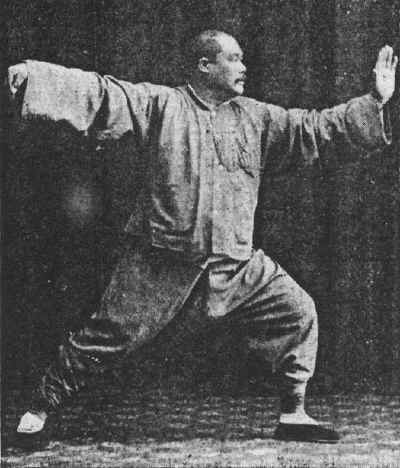
The Mandarin term "tai chi chuan" literally translates as "supreme ultimate boxing" or "boundless fist," but may better translate to "great extremes boxing," with an emphasis on finding balance between two great extremes. The concept of the "supreme ultimate" is the symbol of the Taijitu meant to show the principles of Yin and Yang duality of Taoist philosophy. Thus, tai chi theory and practice evolved in agreement with many of the principles of Chinese philosophy and Taoism in particular. Tai chi training first and foremost involves learning solo routines, known as forms (套路 taolu). While the image of tai chi chuan in popular culture is typified by exceedingly slow movement, many tai chi styles (including the three most popular, Yang, Wu and Chen) have secondary forms of a faster pace. The other half of traditional tai chi training (though many modern schools disregard it entirely) consists of partner exercises known as pushing hands, and martial applications of the postures of the form.
Tai chi chuan was created as a form of traditional Chinese martial arts of the Neijia (soft or internal) branch. Since the first widespread promotion of tai chi's health benefits by Yang Shaohou, Yang Chengfu, Wu Chien-ch'uan and Sun Lutang in the early twentieth century[3], it has developed a worldwide following among people with little or no interest in martial training for its benefit to health and health maintenance[4]. Some call it a form of moving meditation, as focusing the mind solely on the movements of the form purportedly helps to bring about a state of mental calm and clarity. Besides general health benefits and stress management attributed to tai chi training, aspects of Traditional Chinese medicine are taught to advanced tai chi students in some traditional schools.[citation needed] Some martial arts, especially the Japanese martial arts, use a uniform for students during practice. Tai chi chuan schools do not generally require a uniform, but both traditional and modern teachers often advocate loose, comfortable clothing and flat-soled shoes.[5] [6]
The physical techniques of tai chi chuan are described in the tai chi classics (a set of writings by traditional masters) as being characterized by the use of leverage through the joints based on coordination in relaxation, rather than muscular tension, in order to neutralize or initiate attacks. The slow, repetitive work involved in the process of learning how that leverage is generated gently and measurably increases and opens the internal circulation (breath, body heat, blood, lymph, peristalsis, etc.).
The study of tai chi chuan primarily involves three subjects. Traditional schools cover these aspects of tai chi practice simultaneously, while many modern schools focus on a single aspect, depending on their goal in practicing the art. These subjects are:
- Health
- An unhealthy or otherwise uncomfortable person will find it difficult to meditate to a state of calmness or to use tai chi as a martial art. Tai chi's health training therefore concentrates on relieving the physical effects of stress on the body and mind. For those focused on tai chi's martial application, good physical fitness is the first step in effective self-defense.
- Meditation
- The focus and calmness cultivated by the meditative aspect of tai chi is seen as necessary in maintaining optimum health (in the sense of relieving stress and maintaining homeostasis) and in application of the form as a soft style martial art.
- Martial art
- The ability to use tai chi as a form of self-defense in combat is said to be the most effective proof of a student's understanding of the principles of good Tai Chi. The study of tai chi chuan martially is the study of appropriate change in response to outside forces; the study of yielding and blending with outside force rather than attempting to meet it with opposing force.



 Se dice que en el siglo XVI, un chino llamado Chin – Young – Gen – Pin, desarrolló unas presas llamadas Tes, estos Tes o técnicas que consistían en unas pocas proyecciones o presas que tenían como finalidad matar al adversario o herirle antes de su mutilación.
Se dice que en el siglo XVI, un chino llamado Chin – Young – Gen – Pin, desarrolló unas presas llamadas Tes, estos Tes o técnicas que consistían en unas pocas proyecciones o presas que tenían como finalidad matar al adversario o herirle antes de su mutilación. Ahora empiezo con la historia del Brazillian Jiu Jitsu o Gracie Jiu Jitsu: El Jiu Jitsu lo introdujeron en Brasil alrededor de 1916, cuando llegó a Brasil Eisei Mitsuyo Maeda, conocido como "Count Koma" (Conde del combate) que había derrotado a rivales de todos los estilos de pelea de todo el mundo entero. Era maestro de Jiu Jitsu Japonés y se hospedo en la casa de un brasilero llamado Gaston Gracie, un carioca descendiente de Escoceses que era diplomático del gobierno brasilero y una persona influyente en la sociedad.
Ahora empiezo con la historia del Brazillian Jiu Jitsu o Gracie Jiu Jitsu: El Jiu Jitsu lo introdujeron en Brasil alrededor de 1916, cuando llegó a Brasil Eisei Mitsuyo Maeda, conocido como "Count Koma" (Conde del combate) que había derrotado a rivales de todos los estilos de pelea de todo el mundo entero. Era maestro de Jiu Jitsu Japonés y se hospedo en la casa de un brasilero llamado Gaston Gracie, un carioca descendiente de Escoceses que era diplomático del gobierno brasilero y una persona influyente en la sociedad.
